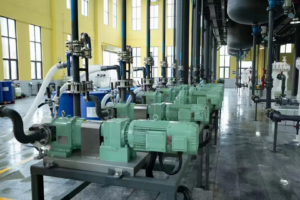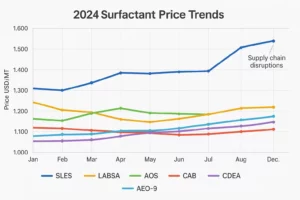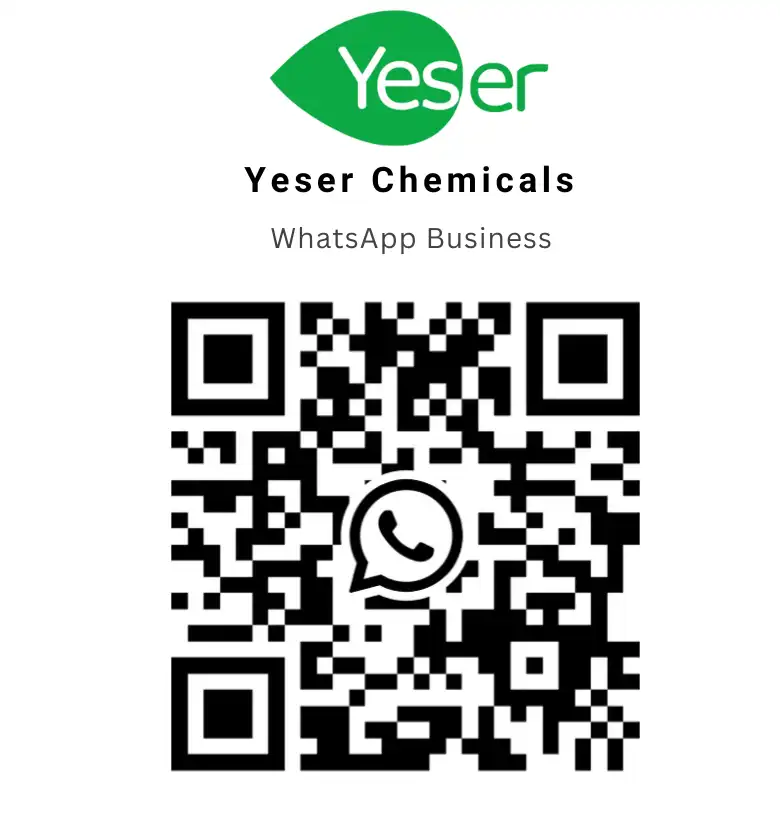As industry insiders, you may have known the intricate balance needed when formulating liquid detergents. One intriguing aspect of this process is the role of a common ingredient – sodium chloride, or salt, in the regulation of product viscosity.
Salt is a critical component in liquid detergent formulas, explicitly used as a cheap thickener to enhance viscosity and consistency. This is because the salt ions (such as sodium and chloride) interact with the hydrophilic head groups of the surfactant molecules, causing them to pack closer together. This results in stronger interactions between the surfactant molecules and a denser micelle network, leading to increased viscosity.
Let’s dive deeper into the underlying chemistry and consider how understanding this phenomenon can empower us to create better, more efficient cleaning products.
The Science Behind Salt and Detergent Viscosity
Salt plays a crucial role as a viscosity builder in liquid detergent formulations. However, its viscosity-building properties do not come from the salt itself, but rather from its interaction with surfactant molecules in the solution. This interplay influences the formation of micelle structure and in turn, modulates the viscosity of the detergent, proving itself to be indispensable in the formulation of effective liquid detergents.
Surfactants in Detergent Formulation
Surfactants are the backbone of any detergent formulation. These substances have the unique ability to reduce the surface tension of water, making it easier for the water to interact with oils and greases and remove them from surfaces. This is due to the amphiphilic nature of surfactants, meaning they contain both hydrophilic (water-loving) and lipophilic (oil-loving) parts.
The hydrophilic part of a surfactant, often referred to as the head, is attracted to water. On the other hand, the lipophilic part, or the tail, is attracted to oils and greases. This structure allows surfactants to surround and lift away dirt and oils, enabling water to rinse them off.
In the context of liquid detergents, surfactants also play a role in building viscosity, the thickness, or resistance to flow, of the detergent.
Surfactant Micelles and Viscosity Building
When surfactants are added to a solution, they self-assemble into structures called micelles once a certain concentration, known as the Critical Micelle Concentration (CMC), is reached. A micelle is formed when the hydrophobic tails of the surfactant molecules cluster together, sheltering from the water, and the hydrophilic heads face outwards, interacting with the surrounding water molecules.
As the concentration of surfactants increases above the CMC, the micelles start to pack together and form larger structures, which can significantly increase the viscosity of the solution. Initially, the surfactant micelles are spherical, but as their concentration increases, they transform into rod-shaped and then into hexagonally packed structures. This transformation is associated with a substantial increase in the solution’s viscosity.

(a) At very low concentrations individual molecules are present. Viscosity is about the same as water.
(b) At higher concentrations, the molecules become associated into spherical micelles. Viscosity is about 100 times that of an unassociated solution.
(c) As the concentration of surfactant increases, with a consequential decrease in the number of water molecules, the spherical micelles become cylinders. Viscosity is about 1000 times that of the unassociated solution.
(d) With high concentrations of surfactants and decreasing water concentrations, the cylinders form hexagonal arrangements. Viscosity is about 10,000 times that of an unassociated solution.
— Source: Chemical formulation – AN OVERVIEW OF SURFACTANT-BASED PREPARATIONS USED IN EVERYDAY LIFE – TONY HARGREAVES
Salt’s Profound Effects on Micelle Forming and Viscosity Result
Adding salt to a surfactant solution can have profound effects on the micelle formation and the resulting viscosity of the solution. The presence of electrolytes like salt in the aqueous phase can induce the formation of more micelles by lowering the CMC. This happens because the salt ions shield the charges on the surfactant molecules, reducing the repulsion between them and encouraging them to form more micelles.
However, the effect of salt on viscosity is not linear. Initially, the addition of salt increases the viscosity of the surfactant solution as more micelles are formed. But after reaching a peak, further addition of salt (oversalting) can decrease the viscosity. This is because oversalting leads to a compression of the electrical double layer around the micelle, leading to an increase in the attractive forces between micelles, and causing them to aggregate and form larger structures. This phenomenon is known as the “salting-out” effect.
Therefore, there is a delicate balance when it comes to the amount of salt added to a detergent formulation. The right amount of salt can increase the detergent’s viscosity to the desired level, but oversalting can reduce it. This highlights the importance of carefully controlling the salt content in detergent formulations to achieve the desired viscosity and cleaning performance.
Not All Surfactants Can Be Effectively Thickened by Salt
While the concept of salt as a viscosity builder holds true for many surfactants, it’s important to note that not all surfactants can be effectively thickened by salt. The salt responsiveness varies among different classes of surfactants. Below are some examples:
- Alkyl Sulfates (e.g., Sodium Lauryl Sulfate – SLS): These surfactants exhibit excellent responsiveness to salt for thickening.
- Alkyl Ether Sulfates (e.g., Sodium Lauryl Ether Sulfate – SLES): These display good thickening responses when salt is added.
- Sulfosuccinates (e.g., Disodium Laureth Sulfosuccinate): Unfortunately, these surfactants do not thicken with the addition of salt.
- Fatty Acid Isethionates (e.g., Sodium Cocoyl Isethionate): These display good responsiveness to salt for thickening.
- Fatty Acid Taurides (e.g., Sodium Cocoyl Methyl Taurate): These have an excellent response to salt for thickening.
- Acyl Glutamates (e.g., Sodium Cocoyl Glutamate): Like Sulfosuccinates, these surfactants don’t thicken with salt.
- Acyl Sarcosinates (e.g., Sodium Lauryl Sarcosinate): They do thicken a little with salt.
- Amphoteric Surfactants (e.g., Cocamidopropyl Betaine, Hydroxysultaines) and Non-Ionic Surfactants (e.g., Alkyl Glucosides): These surfactant categories also do not thicken with salt.
The uneven responsiveness of different surfactants to salt underscores the need for understanding individual surfactant properties when formulating a liquid detergent. It shows that formulating effective and consistent liquid detergent goes beyond merely adding salt, but requires an in-depth understanding of the chemistry of surfactants and their interaction with salt.
Practical Guidelines for Adding Salt to Thicken Detergents
It’s important to understand how to correctly add salt in practical manufacturing to effectively modulate the viscosity of liquid detergents. Here’s a step-by-step guideline, integrating the key points shared above and other essential information, to help you master this process.
- Adjust the Slurry pH: Before you begin adding salt, ensure that the pH of the slurry is properly balanced. pH can have a significant impact on the viscosity of the detergent. A sudden change in pH can either cause a spike or a drop in viscosity. Normally, the optimal pH for most detergents ranges between 7 and 9. Use a reliable pH meter to monitor this.
- Pre-Dissolve the Salt: Rather than adding dry salt directly into the slurry, first, pre-dissolve the salt with a small amount of water. This will ensure that the salt is evenly distributed throughout the detergent mixture, resulting in a more homogeneous product with uniform viscosity.
- Add Salt Gradually: Strictly follow the protocol of adding salt in 0.3 – 0.5% w/w increments at a time. After each addition, allow the mixture to properly incorporate before adding more.
- Monitor the Viscosity: Closely observe and monitor the changes in viscosity after each salt addition. It’s critical to avoid oversalting, which can cause irreversible thinning of the detergent. Use an appropriate viscosity measurement tool like a viscometer for accurate results.
- Be Patient: The process of adding salt and checking viscosity is a gradual one and requires patience. Hurrying it may lead to incorrect viscosity levels, affecting the overall quality of the detergent product.
- Consider the Surfactant Type: Always remember that not all surfactants respond to salt in the same way. Keep the nature of the surfactant in your formulation in mind when adding salt.
Implementing these guidelines into the manufacturing process can ensure better control over the product’s viscosity, leading to superior-quality detergent formulations. Remember, understanding is half the battle – when you comprehend the ‘why’, the ‘how’ becomes much easier to master.
Optimal Surfactant Combinations for Effective Viscosity Building
Surfactants form the cornerstone of detergent formulations, but their incorporation isn’t a simple add-and-stir affair. It revolves around the strategic selection and pairing of different surfactants—known as formulation optimization—aimed at maximizing the efficiency and performance of the final product. Such combinations bring about a ‘surfactant synergy’ where collective performance surpasses individual contributions.
A typical example of an effective surfactant combination that significantly boosts detergent viscosity is Sodium Lauryl Ether Sulfate (SLES) or Sodium Lauryl Sulfate (SLS) combined with Cocamidopropyl Betaine or Cocamide DEA.
This synergy often manifests as improved cleaning performance, boosted foaming, enhanced emulsification or dirt dispersion, and significantly, increased viscosity. By optimizing surfactant systems, detergents become more effective, even at lower concentrations, leading to cost-effectiveness and fostering the production of environmentally friendly products.
However, establishing these combinations demands an in-depth understanding of surfactant properties and their respective interactions. Factors like hydrophilic-lipophilic balance, surfactant charge, and hydrocarbon chain length all influence surfactant interaction in a formulation. Through careful testing and adjustment, this optimization can significantly impact viscosity, affecting the detergent’s application and cleaning behavior.
Exploring Additional Factors/Methods to Enhance Detergent Viscosity
While it’s indisputable that salt plays a significant role in modulating detergent viscosity, it’s equally important to acknowledge that it’s not the sole player. Other factors and methods can also effectively increase detergent viscosity, offering formulators diverse pathways to achieve their desired detergent consistency.
Many factors can influence detergent viscosity. For instance, the choice of surfactants and their concentration significantly impact the viscosity of the solution. We’ve discussed how the addition of a secondary surfactant can enhance the viscosity of the detergent, with exemplary combinations like SLES or SLS coupled with Cocamidopropyl Betaine or Cocamide DEA.
Apart from surfactants and salt, other viscosity-building additives play crucial roles. These include natural gums, cellulose ethers, and synthetic polymers. Moreover, the formulation process—specifically the sequence and method in which ingredients are mixed—can also affect viscosity.
For example, the incorporation of a hydrophilic solvent can modulate detergent viscosity. It can influence surfactant solubilization and micelle formation, ultimately impacting the detergent’s cleanliness performance.
Finally, it’s essential to remember that, beyond chemistry, external conditions, such as temperature and mechanical stress applied during mixing and storage, can also affect detergent viscosity.
For an in-depth examination of these factors and others, we recommend reading our detailed post—“A Comprehensive Guide to Liquid Detergent Viscosity: Understanding the Importance, Factors, and Applications”. This discussion enhances your understanding of detergent viscosity and the labyrinth of factors that influence it, equipping you with the necessary knowledge to develop high-performing, tailor-made detergent formulas.
Conclusion: Harnessing the Synergy of Salt and Surfactants for Enhanced Detergent Viscosity
In conclusion, the art of formulating effective liquid detergents is a delicate balancing act that weaves together intricate elements, one of which is understanding the critical role of salt. Salt, as an electrolyte in detergent solution, plays a transformative role in regulating product viscosity, primarily by facilitating the formation of a denser micelle network through its interaction with surfactant molecules.
Understanding the underlying factors that influence micelle formation—such as surfactant concentration and the addition of salt—is integral to controlling detergent viscosity. Not all surfactants respond uniformly to salt, necessitating judicious dosing of the thickening agent to avoid oversalting, which can result in irreversible thinning.
As we unveil the viscosity secrets embedded in the science of salt and surfactants, we invite you to venture alongside us on this exciting exploration, unraveling the science behind the integrity of everyday products.
A. What are the environmental impacts of using salt in liquid detergents?
While salt is generally considered safe for the environment, excessive amounts of sodium ions can negatively affect soil structure, affecting plant growth. Also, detergents are typically disposed of in wastewater, which, when high in salt content, can prove detrimental to freshwater ecosystems.
B. Can I use sea salt to thicken my liquid detergent?
While sea salt can technically thicken a liquid detergent, it isn’t typically used in formulations due to its impurities and variation in mineral content compared to refined salt. These impurities can impact the consistency and effectiveness of the detergent.
C. How does the salt concentration affect the stability of liquid detergent?
Too much salt can lead to instability in the detergent, causing phase separation or precipitation. On the other hand, the right amount of salt helps maintain the stability of the detergent by increasing its viscosity.
D. Does the type of water affect how much salt is needed in a detergent formula?
Yes, the type and quality of water can impact the amount of salt required. Hard water, which contains ions like calcium and magnesium, may need more salt to achieve the same thickening effect compared to soft water.
E. Are there alternatives to salt for thickening liquid detergents?
Yes, alternatives to salt for thickening liquid detergents include gums, polymers, and even some types of surfactants that can act as thickening agents. The choice depends on the particular requirements of the detergent formulation.






